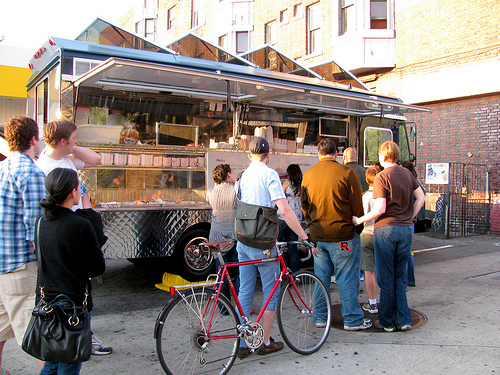It seems folks have a lot to say about Seattle’s food carts. My post last week spurred several others, each with their own lively comment strings (see: the P-I, Crosscut, Seattle Reddit, Publicola, the Sun Break, and Seattle Transit Blog 1 and 2; and beyond Seattle: Vancouver Open File, Georgia Straight, Slate, and Grist).
The topic elicits mixed reactions, ranging from “who cares,” to ardent support, to harsh criticism of Seattle’s current program. I want to follow up with a couple of points that have come up in these discussions.
First: I want to make it clear that I think the verdict is still out on Seattle street food. Yes, the current numbers for applicants who are using city streets and sidewalks are low: around 10 applicants since the rules changed last August. But the numbers are deceptive—and clearer ones are harder to find. King County actually had 408 food carts in 2011. But about half of those were labeled “Risk 1”: basically coffee carts and hotdog vendors. Only 201 carts were “Risk 3,” and permitted to vend their cuisine of choice. To date in 2012, only 163 vendors have applied for Risk 3 permits. It’s very uncertain how many vendors we’ll see as we get closer to summer.
It could very well be that Seattle is on the cusp of an explosion, and vendors are just waiting for sunny skies. Or, new regulations could have added enough costs and process that we’ll see a fall in the number of carts permitted in 2012. It’s just too early to tell.
Second: Other folks have shared some great policy insights. At Slate, Matt Yglesias wonders if it’s really a question of policy mechanics, or if the City is “protecting the profits of incumbent business owners.” Meanwhile on Sightline’s own blog, Fusion on the Run owner Cassandra Seaman explains that finding a place to vend in Seattle is very expensive. High costs for vendors could explain why Seattle’s trucks tend toward costly, high-end cuisine. Additionally, Seaman notes a cart in Portland can open in weeks, while it took her half a year (my understanding is that the permitting process in Seattle has sped up, but is still quite slow compared to Portland).
While the future of Seattle street food is still uncertain, it still seems to me that the city and (maybe more importantly) the county’s policies are stifling to potential business. The City of Seattle should nix the 50 ft setback, list pre-approved vending sites, and drop the no-overnight rule; the King County Department of Health should ditch the commissary requirement and instead require that mobile vendors get their truck, cart, or commissary inspected before they’re permitted to prepare and sell food; and both could work on speeding up the pace of permitting.
Third: A lot of folks worry about the impact of food carts on restaurant business. However, in Portland a thriving street food scene has gone hand-in-hand with a national reputation for the city’s restaurants. Most of the time, the choice isn’t between a sit-down meal or a food cart. Street food is popular at lunch and late at night. You don’t go to a restaurant just for the food—you may also go for the ambiance, leisure, and experience. A food truck can’t replace the same comforts.
Limiting street food is unfair protectionism of brick and mortar restaurants. We don’t outlaw libraries to protect bookstores, even though that industry probably needs more help than restaurants.
Fourth, for the “who cares?” crowd: Yes, there’s a “foodie” element at work here. But street food also makes for good urban policy. It makes neighborhoods more walkable, streets more engaging, and provides affordable food choices. Lower-cost business opportunities are also good for the economy—particularly for immigrant communities and young people.
Over at Seattle Transit Blog Matt Gangemi has a great rundown of what kind of downtown he’d create, given a magic wand. He points out that dense, side-walk oriented businesses—like you have in Pike Place Market—bring down rents and allow for more diverse businesses to grow. They draw more residents into dense, urban settings like downtown.
His solution: open up alleys.









Coclesmary
I completely understand the concerns of the brick and mortar restaurants, but personally, I think the street food and a real restaurant are such different experiences that the brick and mortar folks don’t need to worry. When I’m in the mood for a quick, portable take out meal, I’m fine with the food trucks, but it’s never a substitute for a sit down meal. I don’t think it would ever occur to me to hold up and eat a taco, or sandwich from a truck instead of continuing onto the restaurant I was headed for. Much like the experience of “auto row” where everyone comes to look at cars, the more food in a geographic location the more people turn up to make choices.
kevin
As a restaurant owner I view the presence of food carts as an indicator of a thriving area, not competition. If a street can support street food then it will also be supporting and active business district. Our neighborhood recently lost a taco truck because the rent on the truck was too high. It feels emptier on the corner now with the lunch options left being slower and more expensive. I would like to encourage other restaurant owners to embrace the food carts nearby as they indicate your restaurant is in a good location.
Eric Hess
Great insight, Kevin! Food carts work best where there’s foot traffic, and often bring more foot traffic–making it good for surrounding businesses.